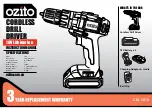
8
2. Removing the bit
Please do the opposite point on the method of installing
bit.
3. Con
fi
rm that the battery is mounted correctly
4. Check the rotational direction
The bit rotates clockwise (viewed from the rear side) by
pushing the R-side of the selector button.
The L-side of the selector button is pushed to turn the bit
counterclockwise (See
Fig. 5
) (The and marks are
provided on the body).
5. Switch operation
◯
When the trigger switch is depressed, the tool rotates.
When the trigger is released, the tool stops.
◯
The rotational speed of the drill can be controlled by
varying the amount that the trigger switch is pulled.
Speed is low when the trigger switch is pulled slightly and
increases as the trigger switch is pulled more.
NOTE
A buzzing noise is produced when the motor is about to
rotate. This is only a noise, not a machine failure.
6. Using the light
Pull the trigger switch to light up the light. The light keeps
on lighting while the trigger switch is being pulled. The
light goes out after releasing the trigger switch. (
Fig. 6
)
CAUTION
Do not look directly into the light. Such actions could
result in eye injury.
7. Tightening and loosening screws
Install the bit that matches the screw, line up the bit in the
grooves of the head of the screw, then tighten it.
Push the impact driver just enough to keep the bit
fi
tting
the head of the screw.
CAUTION
Applying the impact driver for too long tightens the screw
too much and can break it.
Tightening a screw with the impact driver at an angle to
that screw can damage the head of the screw and the
proper force will not be transmitted to the screw.
Tighten with this impact driver lined up straight with the
screw.
8. Tightening and loosening bolts
A hex. socket matching the bolt or nut must
fi
rst be
selected. Then mount the socket on the anvil, and grip
the nut to be tightened with the hex. socket.
Holding the wrench in line with the bolt, press the power
switch to impact the nut for several seconds.
If the nut is only loosely
fi
tted to the bolt, the bolt may turn
with the nut, therefore mistaking proper tightening. In this
case, stop impact on the nut and hold the bolt head with a
wrench before restarting impact, or manually tighten the
bolt and nut to prevent them slipping.
OPERATIONAL CAUTIONS
1. Resting the unit after continuous work
After use for continuous bolt-tightening work, rest the
unit for 15 minutes or so when replacing the battery. The
temperature of the motor, switch, etc., will rise if the work
is started again immediately after battery replacement,
eventually resulting in burnout.
NOTE
Do not touch the metal parts, as it gets very hot during
continuous work.
2. Cautions on use of the speed control switch
This switch has a built-in, electronic circuit which
steplessly varies the rotation speed. Consequently,
when the switch trigger is pulled only slightly (low speed
rotation) and the motor is stopped while continuously
driving in screws, the components of the electronic circuit
parts may overheat and be damaged.
3. Use a tightening time suitable for the screw
The appropriate torque for a screw di
ff
ers according to
the material and size of the screw, and the material being
screwed etc., so please use a tightening time suitable for
the screw. In particular, if a long tightening time is used in
the case of screws smaller than M8, there is a danger of
the screw breaking, so please con
fi
rm the tightening time
and the tightening torque beforehand.
4. Work at a tightening torque suitable for the bolt
under impact
The optimum tightening torque for nuts or bolts di
ff
ers
with material and size of the nuts or bolts. An excessively
large tightening torque for a small bolt may stretch
or break the bolt. The tightening torque increases in
proportion to the operaton time. Use the correct operating
time for the bolt.
5. Con
fi
rm the tightening torque
The following factors contribute to a reduction of the
tightening torque. So con
fi
rm the actual tightening torque
needed by screwing up some bolts before the job with
a hand torque wrench. Factors a
ff
ecting the tightening
torque are as follows.
(1) Voltage
When the discharge margin is reached, voltage
decreases and tightening torque is lowered.
(2) Operating time
The tightening torque increases when the operating time
increases. But the tightening torque does not increase
above a certain value even if the tool is driven for a long
time.
(3) Diameter of bolt
The tightening torque di
ff
ers with the diameter of the bolt.
Generally a larger diameter bolt requires larger tightening
torque.
(4) Tightening conditions
The tightening torque di
ff
ers according to the torque ratio;
class, and length of bolts even when bolts with the same
size threads are used. The tightening torque also di
ff
ers
according to the condition of the surface of workpiece
through which the bolts are to be tightened. When the
bolt and nut turn together, torque is greatly reduced.
MAINTENANCE AND INSPECTION
1. Inspecting the driver bit
Using a broken bit or one with a worn out tip is dangerous
because the bit can slip. Replace it.
2. Inspecting the mounting screws
Regularly inspect all mounting screws and ensure that
they are properly tightened. Should any of the screws be
loose, retighten them immediately. Failure to do so may
result in serious hazard.
3. Maintenance of the motor
The motor unit winding is the very “heart” of the power
tool.
Exercise due care to ensure the winding does not
become damaged and/or wet with oil or water.
4. Cleaning of the outside
When the impact driver is stained, wipe with a soft dry
cloth or a cloth moistened with soapy water. Do not use
chloric solvents, gasoline or paint thinner, as they melt
plastics.
5. Storage
Store the impact driver in a place in which the temperature
is less than 40°C, and out of reach of children.
NOTE
Make sure that the battery is fully charged when stored
for a long period (3 months or more). The battery with
smaller capacity may not be able to be charged when
used, if stored for a long period.
000Book̲WH18DGL.indb 8
000Book̲WH18DGL.indb 8
2015/05/22 14:39:57
2015/05/22 14:39:57































